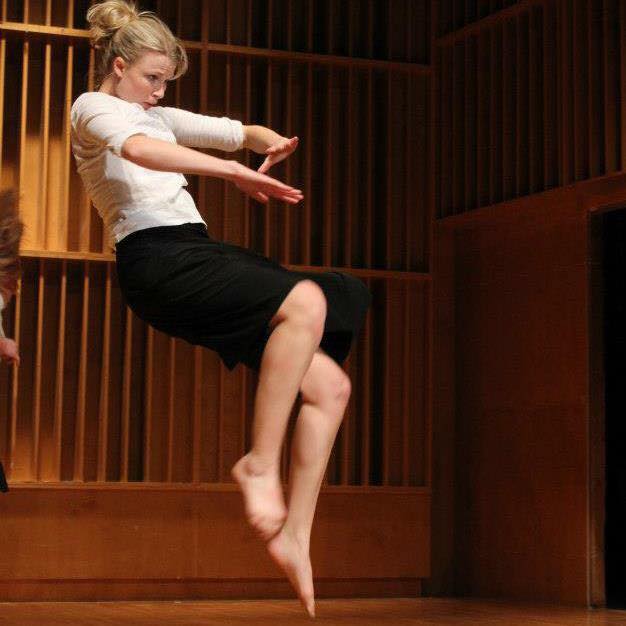Where Dance and Physical Therapy Meet
Abbey Richards is a dancer and physical therapist. She shares how each pursuit has informed the other.
~~
Why did you decide to go into physical therapy? Was it based in your experience in dance?
My experience with physical therapy (PT) started when I was 14. I developed tendinitis and bursitis in both my hips. My young age and the overuse of my hips from dancing about eight hours a day at a summer ballet school was not an ideal combination. In addition to resting from dance, I tried PT for several weeks. Since I was not making any progress with PT, my mom took me to see her Pilates instructor. Within a few Pilates sessions, I was able to relax my hips and let my core musculature support the movement at my pelvis, decreasing my hip pain. My positive experience with Pilates later led me to pursue a certification in Pilates after I finished my degree in modern dance. I taught Pilates for about a year before reaching a roadblock in my knowledge of the human body. This was when I decided to pursue my doctorate in physical therapy. I spent two years teaching Pilates while taking my prerequisites for PT school. I have been working as a PT for nearly a year now.
How can a background in dance aid in a better understanding of physical therapy?
My background in dance has helped me to empathize more with my patients. I connect with each patient’s personal goals and work with the patient to formulate functional and practical goals for rehab. Dancing helps me to see a patient’s form and to kinesthetically feel their form in my own body. I then apply different learning tools – visual, tactile and verbal – to assist each patient in performing a movement with improved biomechanical alignment and form. My dance experiences have enabled me to think more creatively; I always ask for feedback and provide modifications for patients if an exercise is too easy or difficult. Since I am passionate about movement, I am an advocate of “motion is lotion.” I encourage patients to get back to moving, whether it be the simple act of turning one’s head to look side to side or returning to jogging or swimming as a recreational form of exercise.
Vice versa, how can an understanding of physical therapy aid in a more comprehensive knowledge of dance?
My education in physical therapy has made me more acutely aware of the relationship between the mind and the body. I have seen many patients who are limited in their movement due to fear, pain avoidance or depression. These psychosocial factors can play a huge role in the pain cycle, feeding into lack of overall movement. Recognizing this behavior, providing encouragement as appropriate, and helping enable my patients to be more self-sufficient has helped me to become more confident as a person and a dancer. I am better able to recognize my own struggles and fears and to acknowledge and confront them through dance. On the other hand, I am better able to appreciate the gift of dancing and the body that I have been blessed with.
What sorts of pains and stresses (both physical and psychological) have you often seen in patients?
Pain can be caused by biomechanical faults, overuse of a particular joint or muscle, or even disuse. Pain is perceived by each patient differently and causes limitations in his/her daily life. These limitations cause more pain to circulate, creating a vicious cycle for patients. This same cycle is present for all patients, no matter if they are postoperative, suffering from back pain due to poor body mechanics at their job, or recovering from an autoimmune disease. Often the first step to breaking the pain cycle is to acknowledge each patient’s pain. Once his/her voice is heard, I then offer tools that can equip the patient when facing his/her pain. I challenge each patient to complete several exercises at home on their own. This simple act of giving homework to my patients puts them in charge of their success with therapy, and oftentimes leads to self-satisfaction and reduction in pain.
What does well-being look like?
I perceive well-being as a balanced relationship between the mind, body and spirit. If one of those dimensions is struggling, it won’t be long until the other two suffer as well. Consideration of the whole person is integral in healthcare. Connecting to each person and understanding what he/she values is vital to one’s healthy recovery.
~~
Abbey Richard‘s dancing background began in the Ozarks at The Springfield Ballet and Ozark Area Dance Academy. Later, she received a BFA in modern dance and minored in arts administration from Texas Christian University. After college, Abbey became a fully certified STOTT Pilates instructor and taught several years in Texas and Missouri. She also became an active performer/choreographer in the Springfield Dance Alliance. She received her doctorate in physical therapy from Southwest Baptist University, and is now working at Peak Sport and Spine in Columbia, MO. When Abbey is not dancing and rehabilitating patients, she is passionate about spending time with her family and friends, especially while hiking, biking, canoeing, doing yoga, and cooking.
Photos courtesy Springfield Dance Alliance and Jessica Miller


